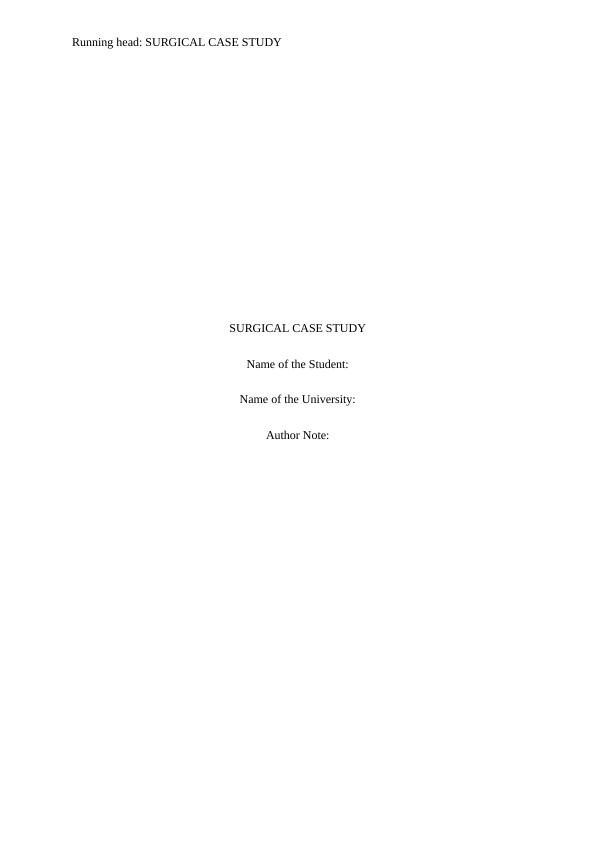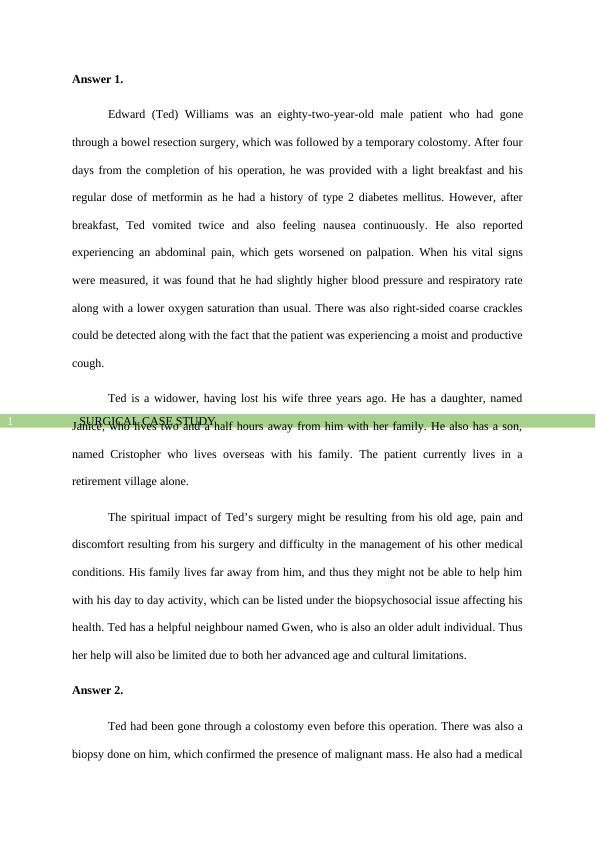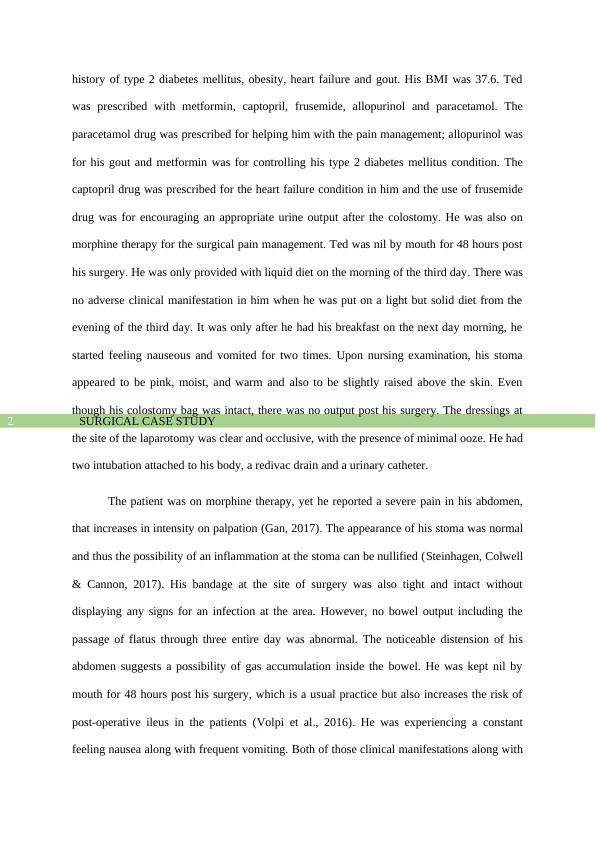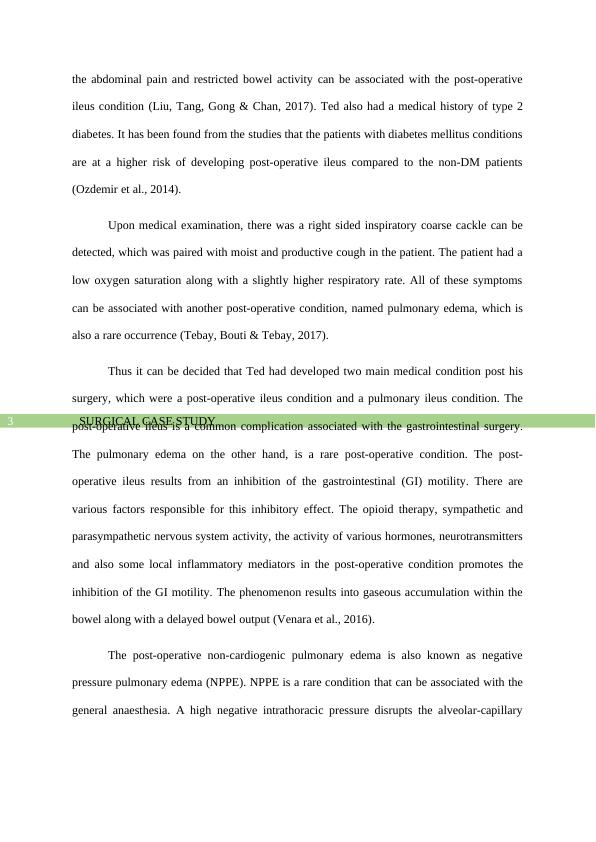Journal of Visceral Surgery
Added on 2022-09-14
11 Pages3002 Words12 Views
Running head: SURGICAL CASE STUDY
SURGICAL CASE STUDY
Name of the Student:
Name of the University:
Author Note:
SURGICAL CASE STUDY
Name of the Student:
Name of the University:
Author Note:

SURGICAL CASE STUDY1
Answer 1.
Edward (Ted) Williams was an eighty-two-year-old male patient who had gone
through a bowel resection surgery, which was followed by a temporary colostomy. After four
days from the completion of his operation, he was provided with a light breakfast and his
regular dose of metformin as he had a history of type 2 diabetes mellitus. However, after
breakfast, Ted vomited twice and also feeling nausea continuously. He also reported
experiencing an abdominal pain, which gets worsened on palpation. When his vital signs
were measured, it was found that he had slightly higher blood pressure and respiratory rate
along with a lower oxygen saturation than usual. There was also right-sided coarse crackles
could be detected along with the fact that the patient was experiencing a moist and productive
cough.
Ted is a widower, having lost his wife three years ago. He has a daughter, named
Janice, who lives two and a half hours away from him with her family. He also has a son,
named Cristopher who lives overseas with his family. The patient currently lives in a
retirement village alone.
The spiritual impact of Ted’s surgery might be resulting from his old age, pain and
discomfort resulting from his surgery and difficulty in the management of his other medical
conditions. His family lives far away from him, and thus they might not be able to help him
with his day to day activity, which can be listed under the biopsychosocial issue affecting his
health. Ted has a helpful neighbour named Gwen, who is also an older adult individual. Thus
her help will also be limited due to both her advanced age and cultural limitations.
Answer 2.
Ted had been gone through a colostomy even before this operation. There was also a
biopsy done on him, which confirmed the presence of malignant mass. He also had a medical
Answer 1.
Edward (Ted) Williams was an eighty-two-year-old male patient who had gone
through a bowel resection surgery, which was followed by a temporary colostomy. After four
days from the completion of his operation, he was provided with a light breakfast and his
regular dose of metformin as he had a history of type 2 diabetes mellitus. However, after
breakfast, Ted vomited twice and also feeling nausea continuously. He also reported
experiencing an abdominal pain, which gets worsened on palpation. When his vital signs
were measured, it was found that he had slightly higher blood pressure and respiratory rate
along with a lower oxygen saturation than usual. There was also right-sided coarse crackles
could be detected along with the fact that the patient was experiencing a moist and productive
cough.
Ted is a widower, having lost his wife three years ago. He has a daughter, named
Janice, who lives two and a half hours away from him with her family. He also has a son,
named Cristopher who lives overseas with his family. The patient currently lives in a
retirement village alone.
The spiritual impact of Ted’s surgery might be resulting from his old age, pain and
discomfort resulting from his surgery and difficulty in the management of his other medical
conditions. His family lives far away from him, and thus they might not be able to help him
with his day to day activity, which can be listed under the biopsychosocial issue affecting his
health. Ted has a helpful neighbour named Gwen, who is also an older adult individual. Thus
her help will also be limited due to both her advanced age and cultural limitations.
Answer 2.
Ted had been gone through a colostomy even before this operation. There was also a
biopsy done on him, which confirmed the presence of malignant mass. He also had a medical

SURGICAL CASE STUDY2
history of type 2 diabetes mellitus, obesity, heart failure and gout. His BMI was 37.6. Ted
was prescribed with metformin, captopril, frusemide, allopurinol and paracetamol. The
paracetamol drug was prescribed for helping him with the pain management; allopurinol was
for his gout and metformin was for controlling his type 2 diabetes mellitus condition. The
captopril drug was prescribed for the heart failure condition in him and the use of frusemide
drug was for encouraging an appropriate urine output after the colostomy. He was also on
morphine therapy for the surgical pain management. Ted was nil by mouth for 48 hours post
his surgery. He was only provided with liquid diet on the morning of the third day. There was
no adverse clinical manifestation in him when he was put on a light but solid diet from the
evening of the third day. It was only after he had his breakfast on the next day morning, he
started feeling nauseous and vomited for two times. Upon nursing examination, his stoma
appeared to be pink, moist, and warm and also to be slightly raised above the skin. Even
though his colostomy bag was intact, there was no output post his surgery. The dressings at
the site of the laparotomy was clear and occlusive, with the presence of minimal ooze. He had
two intubation attached to his body, a redivac drain and a urinary catheter.
The patient was on morphine therapy, yet he reported a severe pain in his abdomen,
that increases in intensity on palpation (Gan, 2017). The appearance of his stoma was normal
and thus the possibility of an inflammation at the stoma can be nullified (Steinhagen, Colwell
& Cannon, 2017). His bandage at the site of surgery was also tight and intact without
displaying any signs for an infection at the area. However, no bowel output including the
passage of flatus through three entire day was abnormal. The noticeable distension of his
abdomen suggests a possibility of gas accumulation inside the bowel. He was kept nil by
mouth for 48 hours post his surgery, which is a usual practice but also increases the risk of
post-operative ileus in the patients (Volpi et al., 2016). He was experiencing a constant
feeling nausea along with frequent vomiting. Both of those clinical manifestations along with
history of type 2 diabetes mellitus, obesity, heart failure and gout. His BMI was 37.6. Ted
was prescribed with metformin, captopril, frusemide, allopurinol and paracetamol. The
paracetamol drug was prescribed for helping him with the pain management; allopurinol was
for his gout and metformin was for controlling his type 2 diabetes mellitus condition. The
captopril drug was prescribed for the heart failure condition in him and the use of frusemide
drug was for encouraging an appropriate urine output after the colostomy. He was also on
morphine therapy for the surgical pain management. Ted was nil by mouth for 48 hours post
his surgery. He was only provided with liquid diet on the morning of the third day. There was
no adverse clinical manifestation in him when he was put on a light but solid diet from the
evening of the third day. It was only after he had his breakfast on the next day morning, he
started feeling nauseous and vomited for two times. Upon nursing examination, his stoma
appeared to be pink, moist, and warm and also to be slightly raised above the skin. Even
though his colostomy bag was intact, there was no output post his surgery. The dressings at
the site of the laparotomy was clear and occlusive, with the presence of minimal ooze. He had
two intubation attached to his body, a redivac drain and a urinary catheter.
The patient was on morphine therapy, yet he reported a severe pain in his abdomen,
that increases in intensity on palpation (Gan, 2017). The appearance of his stoma was normal
and thus the possibility of an inflammation at the stoma can be nullified (Steinhagen, Colwell
& Cannon, 2017). His bandage at the site of surgery was also tight and intact without
displaying any signs for an infection at the area. However, no bowel output including the
passage of flatus through three entire day was abnormal. The noticeable distension of his
abdomen suggests a possibility of gas accumulation inside the bowel. He was kept nil by
mouth for 48 hours post his surgery, which is a usual practice but also increases the risk of
post-operative ileus in the patients (Volpi et al., 2016). He was experiencing a constant
feeling nausea along with frequent vomiting. Both of those clinical manifestations along with

SURGICAL CASE STUDY3
the abdominal pain and restricted bowel activity can be associated with the post-operative
ileus condition (Liu, Tang, Gong & Chan, 2017). Ted also had a medical history of type 2
diabetes. It has been found from the studies that the patients with diabetes mellitus conditions
are at a higher risk of developing post-operative ileus compared to the non-DM patients
(Ozdemir et al., 2014).
Upon medical examination, there was a right sided inspiratory coarse cackle can be
detected, which was paired with moist and productive cough in the patient. The patient had a
low oxygen saturation along with a slightly higher respiratory rate. All of these symptoms
can be associated with another post-operative condition, named pulmonary edema, which is
also a rare occurrence (Tebay, Bouti & Tebay, 2017).
Thus it can be decided that Ted had developed two main medical condition post his
surgery, which were a post-operative ileus condition and a pulmonary ileus condition. The
post-operative ileus is a common complication associated with the gastrointestinal surgery.
The pulmonary edema on the other hand, is a rare post-operative condition. The post-
operative ileus results from an inhibition of the gastrointestinal (GI) motility. There are
various factors responsible for this inhibitory effect. The opioid therapy, sympathetic and
parasympathetic nervous system activity, the activity of various hormones, neurotransmitters
and also some local inflammatory mediators in the post-operative condition promotes the
inhibition of the GI motility. The phenomenon results into gaseous accumulation within the
bowel along with a delayed bowel output (Venara et al., 2016).
The post-operative non-cardiogenic pulmonary edema is also known as negative
pressure pulmonary edema (NPPE). NPPE is a rare condition that can be associated with the
general anaesthesia. A high negative intrathoracic pressure disrupts the alveolar-capillary
the abdominal pain and restricted bowel activity can be associated with the post-operative
ileus condition (Liu, Tang, Gong & Chan, 2017). Ted also had a medical history of type 2
diabetes. It has been found from the studies that the patients with diabetes mellitus conditions
are at a higher risk of developing post-operative ileus compared to the non-DM patients
(Ozdemir et al., 2014).
Upon medical examination, there was a right sided inspiratory coarse cackle can be
detected, which was paired with moist and productive cough in the patient. The patient had a
low oxygen saturation along with a slightly higher respiratory rate. All of these symptoms
can be associated with another post-operative condition, named pulmonary edema, which is
also a rare occurrence (Tebay, Bouti & Tebay, 2017).
Thus it can be decided that Ted had developed two main medical condition post his
surgery, which were a post-operative ileus condition and a pulmonary ileus condition. The
post-operative ileus is a common complication associated with the gastrointestinal surgery.
The pulmonary edema on the other hand, is a rare post-operative condition. The post-
operative ileus results from an inhibition of the gastrointestinal (GI) motility. There are
various factors responsible for this inhibitory effect. The opioid therapy, sympathetic and
parasympathetic nervous system activity, the activity of various hormones, neurotransmitters
and also some local inflammatory mediators in the post-operative condition promotes the
inhibition of the GI motility. The phenomenon results into gaseous accumulation within the
bowel along with a delayed bowel output (Venara et al., 2016).
The post-operative non-cardiogenic pulmonary edema is also known as negative
pressure pulmonary edema (NPPE). NPPE is a rare condition that can be associated with the
general anaesthesia. A high negative intrathoracic pressure disrupts the alveolar-capillary

End of preview
Want to access all the pages? Upload your documents or become a member.
Related Documents
His daughter might also face difficultylg...
|10
|3026
|23
Pain Management | Nursing Assignmentlg...
|8
|2416
|35
Nursing Questions and Answers 2022lg...
|9
|2454
|22
Principles Of Nursing And Ethicslg...
|11
|2943
|25
Surgical Nursing Question Answer 2022lg...
|10
|2820
|30
NRSG258 Principles of Nursing: Mr. Ted’s Case | Assignmentlg...
|11
|2919
|28
